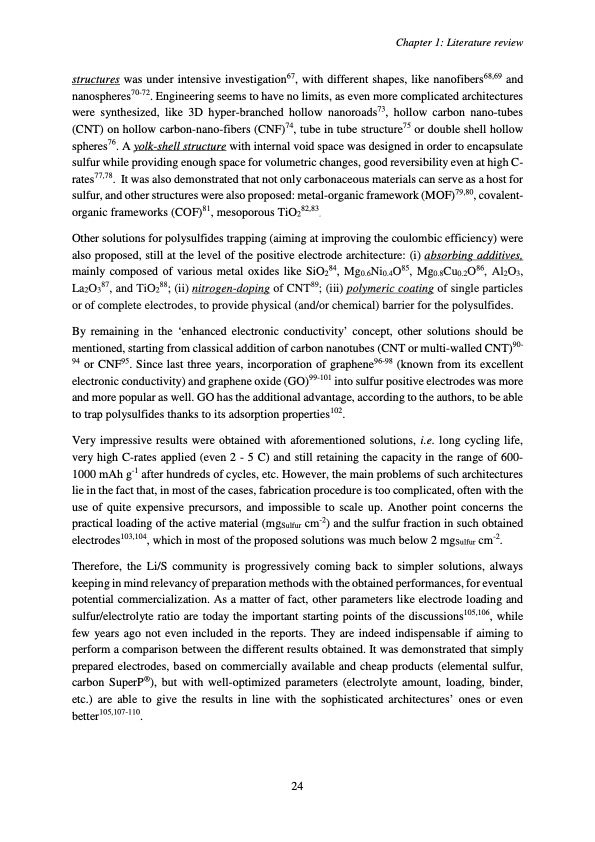
PDF Publication Title:
Text from PDF Page: 028
structures was under intensive investigation67, with different shapes, like nanofibers68,69 and nanospheres70-72. Engineering seems to have no limits, as even more complicated architectures were synthesized, like 3D hyper-branched hollow nanoroads73, hollow carbon nano-tubes (CNT) on hollow carbon-nano-fibers (CNF)74, tube in tube structure75 or double shell hollow spheres76. A yolk-shell structure with internal void space was designed in order to encapsulate sulfur while providing enough space for volumetric changes, good reversibility even at high C- rates77,78. It was also demonstrated that not only carbonaceous materials can serve as a host for sulfur, and other structures were also proposed: metal-organic framework (MOF)79,80, covalent- organic frameworks (COF)81, mesoporous TiO282,83. Other solutions for polysulfides trapping (aiming at improving the coulombic efficiency) were also proposed, still at the level of the positive electrode architecture: (i) absorbing additives, mainly composed of various metal oxides like SiO284, Mg0.6Ni0.4O85, Mg0.8Cu0.2O86, Al2O3, La2O387, and TiO288; (ii) nitrogen-doping of CNT89; (iii) polymeric coating of single particles or of complete electrodes, to provide physical (and/or chemical) barrier for the polysulfides. By remaining in the ‘enhanced electronic conductivity’ concept, other solutions should be mentioned, starting from classical addition of carbon nanotubes (CNT or multi-walled CNT)90- 94 or CNF95. Since last three years, incorporation of graphene96-98 (known from its excellent electronic conductivity) and graphene oxide (GO)99-101 into sulfur positive electrodes was more and more popular as well. GO has the additional advantage, according to the authors, to be able to trap polysulfides thanks to its adsorption properties102. Very impressive results were obtained with aforementioned solutions, i.e. long cycling life, very high C-rates applied (even 2 - 5 C) and still retaining the capacity in the range of 600- 1000 mAh g-1 after hundreds of cycles, etc. However, the main problems of such architectures lie in the fact that, in most of the cases, fabrication procedure is too complicated, often with the use of quite expensive precursors, and impossible to scale up. Another point concerns the practical loading of the active material (mgSulfur cm-2) and the sulfur fraction in such obtained electrodes103,104, which in most of the proposed solutions was much below 2 mgSulfur cm-2. Therefore, the Li/S community is progressively coming back to simpler solutions, always keeping in mind relevancy of preparation methods with the obtained performances, for eventual potential commercialization. As a matter of fact, other parameters like electrode loading and sulfur/electrolyte ratio are today the important starting points of the discussions105,106, while few years ago not even included in the reports. They are indeed indispensable if aiming to perform a comparison between the different results obtained. It was demonstrated that simply prepared electrodes, based on commercially available and cheap products (elemental sulfur, carbon SuperP®), but with well-optimized parameters (electrolyte amount, loading, binder, etc.) are able to give the results in line with the sophisticated architectures’ ones or even better105,107-110. Chapter 1: Literature review 24PDF Image | Accumulateur Lithium Soufre

PDF Search Title:
Accumulateur Lithium SoufreOriginal File Name Searched:
WALUS_2015_archivage.pdfDIY PDF Search: Google It | Yahoo | Bing
Sulfur Deposition on Carbon Nanofibers using Supercritical CO2 Sulfur Deposition on Carbon Nanofibers using Supercritical CO2. Gamma sulfur also known as mother of pearl sulfur and nacreous sulfur... More Info
CO2 Organic Rankine Cycle Experimenter Platform The supercritical CO2 phase change system is both a heat pump and organic rankine cycle which can be used for those purposes and as a supercritical extractor for advanced subcritical and supercritical extraction technology. Uses include producing nanoparticles, precious metal CO2 extraction, lithium battery recycling, and other applications... More Info
| CONTACT TEL: 608-238-6001 Email: greg@infinityturbine.com | RSS | AMP |